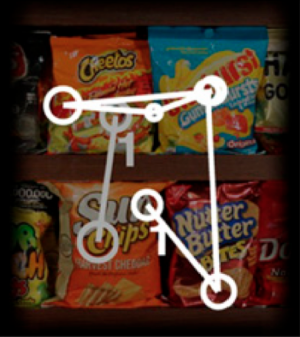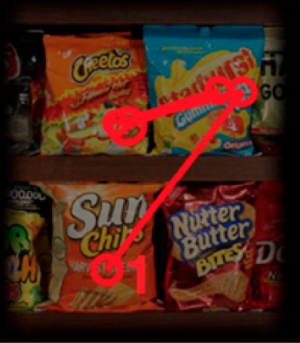
The left image shows actual eye movements of two different persons choosing among four snack items as recorded with eye-tracking. Number "1" indicates where the first eye movement is made to. The right image shows predicted eye movements for the same two choice trials made using only the visual properties of the image and persons' stated preferences for the four items as input. The researchers are able to fairly accurately predict where people will look when making their choices and can use this information to predict which items people will ultimately choose to eat. Credit: PNAS grants permission for the use of this figure from Towal, B., Mormann, M., Koch, C. (2013), "Simultaneous Modeling of Visual Saliency and Value Computation Improves Prediction of Economic Choice." Proceedings of the National Academy of Sciences, 110 (40) E3858-E3867.
When it comes to deciding what food to eat, one might expect that people's choices will be driven by past experience and personal preference, but how does the general appearance of the package impact buying decisions of consumers?
Scientists believe colorful or otherwise noticeable food packages predispose where people look, how long they examine certain options and ultimately, influence which foods they choose, according to a new study published in the Proceedings of the National Academy of Sciences.
"When choice options are presented simultaneously, eye movements are considered a good predictor of our economic decisions," says Milica Mormann, senior research scientist at the University of Miami School of Law and co-author of the study. "The big idea here is that perceptual processes happen in the brain in parallel with economic value computations and thus influence how economic decisions are made."
"These findings can be applied to guide the design of choice environments, to 'nudge' people toward making optimal choices, be it selecting a healthy food option to eat or the best retirement plan to invest in," Mormann says. In the study, Mormann and researchers from the California Institute of Technology, Pasadena, CA asked participants to search for and choose a snack food item to eat—such as M&Ms or Twix—out of four simultaneously presented snack alternatives. Eye-tracking technology recorded what items people were looking at, in real time.
Images of food items were also analyzed using novel neuro-computational simulation of human attentional processes to determine which items attract attention due to the color, brightness and other visual features of their packaging. The experiment showed that visual fixations are driven by a combination of visual attractiveness and preference information. In fact, the visual attractiveness of product packaging influences where people look in a ratio of 1:3 or 2:3 compared to consumer preferences. In other words, visual attractiveness has a smaller, but significant, influence than food preferences on consumer decisions.

The left image shows actual eye movements of two different persons choosing among four snack items as recorded with eye-tracking. Number "1" indicates where the first eye movement is made to. The right image shows predicted eye movements for the same two choice trials made using only the visual properties of the image and persons' stated preferences for the four items as input. The researchers are able to fairly accurately predict where people will look when making their choices and can use this information to predict which items people will ultimately choose to eat. Credit: PNAS grants permission for the use of this figure from Towal, B., Mormann, M., Koch, C. (2013), "Simultaneous Modeling of Visual Saliency and Value Computation Improves Prediction of Economic Choice." Proceedings of the National Academy of Sciences, 110 (40) E3858-E3867.
Importantly, these findings allowed the scientists to accurately predict eye-movement patterns and subsequent food choices using only the images of food items and participants' stated liking ratings of these food items. The accuracy of prediction was higher when both visual features and preferences are accounted for than when only the preference information, or asking people what they like, was considered.
Most existing studies on how people make choices do not examine what is visually appealing but, instead, focus on what is economically attractive. A separate body of literature, dedicated to perceptual decision-making, examines what people perceive and pay attention to. The current study bridges these two research approaches to build a more comprehensive understanding of how people make everyday choices.

The left image shows actual eye movements of two different persons choosing among four snack items as recorded with eye-tracking. Number "1" indicates where the first eye movement is made to. The right image shows predicted eye movements for the same two choice trials made using only the visual properties of the image and persons' stated preferences for the four items as input. The researchers are able to fairly accurately predict where people will look when making their choices and can use this information to predict which items people will ultimately choose to eat. Credit: PNAS grants permission for the use of this figure from Towal, B., Mormann, M., Koch, C. (2013), "Simultaneous Modeling of Visual Saliency and Value Computation Improves Prediction of Economic Choice." Proceedings of the National Academy of Sciences, 110 (40) E3858-E3867.
"Surprisingly, the traditional research approach tends to ignore other, fundamental influences that could impact decision makers at the time of choice, such as how people perceive choice options and how much attention they allocate to different options," Mormann says.
The new study makes an important observation: during the economic choice process the brain merges and reconciles competing types of inputs, including, but not limited to, the perceptual and taste preference information.
with economic value computations and thus influence how economic decisions are made."
"These findings can be applied to guide the design of choice environments, to 'nudge' people toward making optimal choices, be it selecting a healthy food option to eat or the best retirement plan to invest in," Mormann says. In the study, Mormann and researchers from the California Institute of Technology, Pasadena, CA asked participants to search for and choose a snack food item to eat—such as M&Ms or Twix—out of four simultaneously presented snack alternatives. Eye-tracking technology recorded what items people were looking at, in real time.
Images of food items were also analyzed using novel neuro-computational simulation of human attentional processes to determine which items attract attention due to the color, brightness and other visual features of their packaging. The experiment showed that visual fixations are driven by a combination of visual attractiveness and preference information. In fact, the visual attractiveness of product packaging influences where people look in a ratio of 1:3 or 2:3 compared to consumer preferences. In other words, visual attractiveness has a smaller, but significant, influence than food preferences on consumer decisions.





